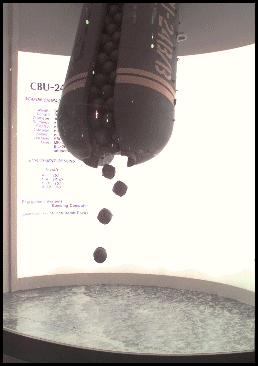
A variant, the CBU-29, has a mix of instantaneous and delayed detonation bomblets. The delay is random, up to 30 minutes after impact. Its more for area denial. Neither is worth much as an anti-materiel weapon - not enough blast power. The CBU-52 has grapefruit sized bomblets, about 335 of them, and is also an anti-materiel weapon. AFAIK they all leave duds - bad news if you have to go into the area later.
When you employ the CBUs you have to take into account how big a pattern you want - due to the spin of the canister and the flutes on the bomblets they migrate sideways after release. Drop one too high and it functions early and the pattern on the ground has a hole in the donut. Thus an accurate drop could lead to missing the target. Dropped too close the pattern can be over-concentrated. This last isn't of much concern to the dropper.
The CBU has both a safe-arm time and a function time. Safe arm time is normally set to 4 seconds, to let the thing drop away from the plane before the fuze arms. Functioning (opening the canister) is by one of two methods, depending as to whether one has a time fuze or radar fuze. One checks the mission, then refers to precomped data from the weapons manual to pick the function time or altitude. 3000 AGL was a pretty common functioning altitude for troops in the open, SEAD, or general dive bomb delivery. However, we were once fragged for SEAD, covering a helo evac up by Dong Hoi (or Hue - I forget which now). the problem was NVN with 51 cal across a river shooting at the helos.
We had 4 F4s with 6 CBU 24 each. I briefed and led the flight. I briefed a low angle delivery, 20 degree dive at 500K, releasing one CBU per pass, on call from the ground. We dropped at around 2300 feet AGL with a 2 second arm time with the radar fuzes set at 800 AGL. This gave us a concentrated pattern comprising an elongated ellipse on the ground. In effect, rather like an instant strafing pass. (Our F4Ds did not have a gun). Every time we dropped a CBU the MG fire stopped for quite awhile. I suppose they had to get a new crew or maybe even a new MG after each pass. The helo evac was successful with no helo losses. The same result might have been attained by conventional dive bombing with the same radar altitude set, but by coming in low-angle we could pin-point the target without a mark from the GFAC. As it was, the delivery method was very similar to a combat strafing pass only much more effective due to the 665 bomblets released each time.
Walter Bjourneyby
©2003 www.G2mil.com
Letters
CBU-24
The Rhodesians had something similar, called an alpha bomb, but I'm
guessing that it was smaller since they dropped them from Lynxes -aka Cessna
337s or O-2s. Their wrinkle was to paint the bomblets bright orange so the
advancing ground troops had a better chance of spotting the duds. Possibly under
certain conditions this allowed the pilot to see the pattern in flight and
assess his coverage?
Phil West